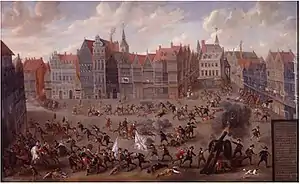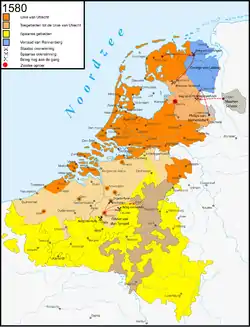English Fury at Mechelen
The English Fury at Mechelen or the Capture of Mechelen was an event in the Eighty Years' War and the Anglo–Spanish War on April 9, 1580. The city of Mechelen was conquered by Calvinist forces from Brussels which included a large contingent of English mercenaries. The city was brutally sacked and its religious treasures destroyed or plundered.[2]
| English Fury | |||||||
|---|---|---|---|---|---|---|---|
| Part of the Eighty Years' War & the Anglo–Spanish War | |||||||
 The English fury on the Grote Markt in Mechelen by Nicolaas van Eyck | |||||||
| |||||||
| Belligerents | |||||||
|
| |||||||
| Commanders and leaders | |||||||
|
| |||||||
Prelude
In 1579, the Lordship of Mechelen was one of the few territories in the Netherlands that had remained loyal to the Spanish King. Most surrounding cities, like Antwerp, Brussels and Ghent were ruled by Calvinists. There in 1580, plans were made to take over all remaining loyal cities, to deny the Spanish army any stronghold behind the frontline.[3]

Mechelen taken
The Calvinist mayor of Brussels, Olivier van den Tympel, gathered a military force, supported by English troops under command of John Norreys and Scottish under command of Captain Stuart. After a short battle with Mechelen's Schutterij and Spanish troops the city was easily taken.[4]
The English however turned against the population and plundered homes, churches and monasteries, later on the tombstones were removed from the cemeteries and sold in England. Some sixty civilians were killed and Archbishop Mathias Hovius hid in a cupboard for three days and then fled the city, dressed as a peasant. The Carmelite monk Petrus de Wolf participated in the defence of the city and was killed by John Norreys himself with his bare hands.[2][4]
Mechelen remained under Calvinist rule until it was reconquered in 1585 by the Spanish under Alexander Farnese, Duke of Parma as one of the last cities in the Southern Netherlands.[3]
The 1580 event was named the English Fury after the Spanish Fury that hit the city in 1572.[5]
References
- Citations
- Tracy pg 82
- Harline & Put p. 127–129
- Nolan, J. p 46
- Knight, Charles Raleigh: Historical records of The Buffs, East Kent Regiment (3rd Foot) formerly designated the Holland Regiment and Prince George of Denmark's Regiment. Vol I. London, Gale & Polden, 1905, p. 18
- Nolan, C. p 269
- Bibliography
- Harline & Put, Craig E. & Eddy F. (2002). Verloren schapen, schurftige herders: de helse dagen van bisschop Mathias Hovius (1542-1620). Davidsfonds/Leuven. ISBN 9789058750631. (Dutch)
- Nolan, Cathal J. (2006). The Age of Wars of Religion, 1000-1650: An Encyclopedia of Global Warfare and Civilization, Volume 1. Greenwood Publishing Group. ISBN 9780313337338.
- Nolan, John S. (1997). Sir John Norreys and the Elizabethan Military World. Liverpool University Press - Liverpool Science Fiction Texts and Studies. ISBN 9780859895484.
- Tracy, J.D. (2008). The Founding of the Dutch Republic: War, Finance, and Politics in Holland 1572–1588. Oxford University Press. ISBN 978-0-19-920911-8.
- External links